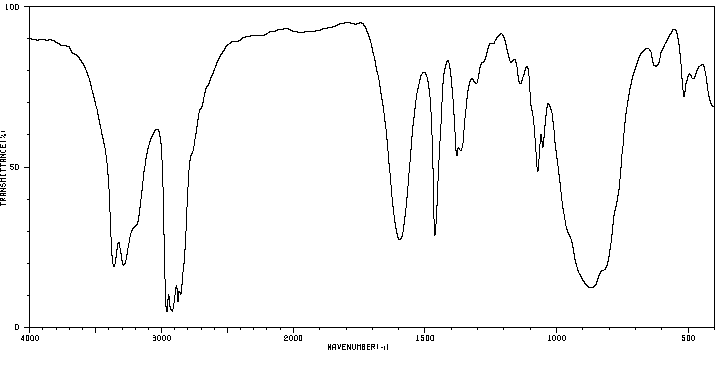1,2-二氨基丁烷 | 4426-48-6
中文名称
1,2-二氨基丁烷
中文别名
——
英文名称
1,2-butanediamine
英文别名
1,2-diamino-n-butane;butane-1,2-diamine;1,2-diaminobutane;1-ethyl-ethanediyldiamine;1-Aethyl-aethandiyldiamin;ethyl-1,2-ethanediamine
CAS
4426-48-6
化学式
C4H12N2
mdl
MFCD00082190
分子量
88.1527
InChiKey
ULEAQRIQMIQDPJ-UHFFFAOYSA-N
BEILSTEIN
——
EINECS
——
-
物化性质
-
计算性质
-
ADMET
-
安全信息
-
SDS
-
制备方法与用途
-
上下游信息
-
文献信息
-
表征谱图
-
同类化合物
-
相关功能分类
-
相关结构分类
计算性质
-
辛醇/水分配系数(LogP):-0.7
-
重原子数:6
-
可旋转键数:2
-
环数:0.0
-
sp3杂化的碳原子比例:1.0
-
拓扑面积:52
-
氢给体数:2
-
氢受体数:2
安全信息
-
海关编码:2921290000
SDS
反应信息
-
作为反应物:参考文献:名称:1−アクリロイルイミダゾリジン−2−オン化合物摘要:这是一种期望应用于细胞培养材料、温度响应性聚合物材料等领域的化合物,其化学式为(1)中所示的1-丙烯酰咪唑啉-2-酮化合物。(在该式中,R1a代表氢原子、碳数为1〜4的烷基、苄基或由式(2)表示的氧烷基,R2a代表氢原子、碳数为1〜4的烷基,R3a代表氢原子或甲基基团。)【选择图】无公开号:JP2021031462A
-
作为产物:参考文献:名称:Strack; Fanselow, Hoppe-Seyler's Zeitschrift fur Physiologische Chemie, 1929, vol. 180, p. 158摘要:DOI:
文献信息
-
Structure–Activity Relationship Study of Dexrazoxane Analogues Reveals ICRF-193 as the Most Potent Bisdioxopiperazine against Anthracycline Toxicity to Cardiomyocytes Due to Its Strong Topoisomerase IIβ Interactions作者:Anna Jirkovská、Galina Karabanovich、Jan Kubeš、Veronika Skalická、Iuliia Melnikova、Jan Korábečný、Tomáš Kučera、Eduard Jirkovský、Lucie Nováková、Hana Bavlovič Piskáčková、Josef Škoda、Martin Štěrba、Caroline A. Austin、Tomáš Šimůnek、Jaroslav RohDOI:10.1021/acs.jmedchem.0c02157日期:2021.4.8interaction with TOP2B in cardiomyocytes, but was independent of their iron chelation ability. Very tight structure–activity relationships were demonstrated on stereoisomeric forms of 4,4′-(butane-2,3-diyl)bis(piperazine-2,6-dione). In contrast to its rac-form 12, meso-derivative 11 (ICRF-193) showed a favorable binding mode to topoisomerase II in silico, inhibited and depleted TOP2B in cardiomyocytes more efficiently右雷佐生 (ICRF-187) 是唯一临床批准的抗蒽环类药物引起的心脏毒性的药物,其心脏保护活性传统上归因于其铁螯合代谢物。然而,最近的实验证据表明,右雷佐生抑制和/或消耗拓扑异构酶 IIβ (TOP2B) 可能具有心脏保护作用。因此,我们评估了一系列右雷佐生类似物,发现它们的心脏保护活性与其与心肌细胞中TOP2B的相互作用密切相关,但与其铁螯合能力无关。 4,4'-(丁烷-2,3-二基)双(哌嗪-2,6-二酮)的立体异构形式证明了非常紧密的结构-活性关系。与其外消旋形式12相比,内消旋衍生物11 (ICRF-193)在计算机模拟中显示出与拓扑异构酶 II 良好的结合模式,比右雷佐生更有效地抑制和耗尽心肌细胞中的 TOP2B,并显示出最高的心脏保护效率。重要的是,观察到的 ICRF-193 心脏保护作用不会干扰蒽环类药物的抗增殖活性。因此,本研究将 ICRF-193 确定为开发有效心脏保护剂的新先导化合物。
-
[EN] 3-PYRIDYL CARBOXAMIDE-CONTAINING SPLEEN TYROSINE KINASE (Syk) INHIBITORS<br/>[FR] INHIBITEURS DE TYROSINE KINASE DE LA RATE (SYK) CONTENANT UN 3-PYRIDYL CARBOXAMIDE申请人:MERCK SHARP & DOHME公开号:WO2013052393A1公开(公告)日:2013-04-11The invention provides certain 3-pyridyl carboxamide-containing compounds of the Formula (I) (I) or pharmaceutically acceptable salts thereof, wherein A and B are as defined herein. The invention also provides pharmaceutical compositions comprising such compounds, and methods of using the compounds for treating diseases or conditions mediated by Spleen Tyrosine Kinase (Syk) kinase.
-
Preparation and Thermal Square Planar–Octahedral Transformation of Nickel(II) Complexes Containing 1,2-Butanediamine or 3,3-Dimethyl-1,2-butanediamine in Solid Phase作者:Yoshinori Ihara、Akiko Wada、Yutaka Fukuda、Kozo SoneDOI:10.1246/bcsj.59.2309日期:1986.7Nickel(II) complexes of 1,2-butanediamine(1,2-bn) and 3,3-dimethyl-1,2-butanediamine(dmbn), were prepared, and their thermal behavior was investigated in solid phase. The original complexes were all violet, octahedral diaquabis(diamine) complexes([Ni(H2O)2(1,2-bn/dmbn)2]X2; X=Cl, Br, NO3, or ClO4). The 1,2-bn complexes with Cl− or Br− and the dmbn complex with NO3− showed a two-step thermochromism制备了 1,2-丁二胺 (1,2-bn) 和 3,3-二甲基-1,2-丁二胺 (dmbn) 的镍 (II) 配合物,并在固相中研究了它们的热行为。最初的配合物都是紫色的八面体双(二胺)配合物([Ni(H2O)2(1,2-bn/dmbn)2]X2;X=Cl、Br、NO3或ClO4)。与 Cl- 或 Br- 的 1,2-bn 配合物和与 - 的 dmbn 配合物在加热时显示出两步热致变色现象,紫色→黄色→紫蓝色。这些步骤对应于方形平面酸酐的结构变化,然后是八面体二阴离子复合物。两种配体与 − 的配合物仅经历热脱水,变成橙色方形平面酸酐。其他盐,1,2-bn 与 - 的复合物和 dmbn 与 Cl- 或 Br- 的复合物,通过一步发生的热脱水-阴离子将它们转化为八面体二阴离子配合物。不同二胺配合物的热反应性差异可以根据二胺引起的空间位阻来理解。
-
3-Pyridyl Carboxamide-Containing Spleen Tyrosine Kinase (SYK) Inhibitors申请人:MERCH SHARP & DOHME CORP.公开号:US20140303206A1公开(公告)日:2014-10-09The invention provides certain 3-pyridyl carboxamide-containing compounds of the Formula (I) (I) or pharmaceutically acceptable salts thereof, wherein A and B are as defined herein. The invention also provides pharmaceutical compositions comprising such compounds, and methods of using the compounds for treating diseases or conditions mediated by Spleen Tyrosine Kinase (Syk) kinase.
-
3-pyridyl carboxamide-containing spleen tyrosine kinase (SYK) inhibitors申请人:Merck Sharp & Dohme Corp.公开号:US08987456B2公开(公告)日:2015-03-24The invention provides certain 3-pyridyl carboxamide-containing compounds of the Formula (I) (I) or pharmaceutically acceptable salts thereof, wherein A and B are as defined herein. The invention also provides pharmaceutical compositions comprising such compounds, and methods of using the compounds for treating diseases or conditions mediated by Spleen Tyrosine Kinase (Syk) kinase.
表征谱图
-
氢谱1HNMR
-
质谱MS
-
碳谱13CNMR
-
红外IR
-
拉曼Raman
-
峰位数据
-
峰位匹配
-
表征信息
同类化合物
(乙腈)二氯镍(II)
(R)-(-)-α-甲基组胺二氢溴化物
(N-(2-甲基丙-2-烯-1-基)乙烷-1,2-二胺)
(4-(苄氧基)-2-(哌啶-1-基)吡啶咪丁-5-基)硼酸
(11-巯基十一烷基)-,,-三甲基溴化铵
鼠立死
鹿花菌素
鲸蜡醇硫酸酯DEA盐
鲸蜡硬脂基二甲基氯化铵
鲸蜡基胺氢氟酸盐
鲸蜡基二甲胺盐酸盐
高苯丙氨醇
高箱鲀毒素
高氯酸5-(二甲氨基)-1-({(E)-[4-(二甲氨基)苯基]甲亚基}氨基)-2-甲基吡啶正离子
高氯酸2-氯-1-({(E)-[4-(二甲氨基)苯基]甲亚基}氨基)-6-甲基吡啶正离子
高氯酸2-(丙烯酰基氧基)-N,N,N-三甲基乙铵
马诺地尔
马来酸氢十八烷酯
马来酸噻吗洛尔EP杂质C
马来酸噻吗洛尔
马来酸倍他司汀
顺式环己烷-1,3-二胺盐酸盐
顺式氯化锆二乙腈
顺式吡咯烷-3,4-二醇盐酸盐
顺式双(3-甲氧基丙腈)二氯铂(II)
顺式3,4-二氟吡咯烷盐酸盐
顺式1-甲基环丙烷1,2-二腈
顺式-二氯-反式-二乙酸-氨-环己胺合铂
顺式-二抗坏血酸(外消旋-1,2-二氨基环己烷)铂(II)水合物
顺式-N,2-二甲基环己胺
顺式-4-甲氧基-环己胺盐酸盐
顺式-4-环己烯-1.2-二胺
顺式-4-氨基-2,2,2-三氟乙酸环己酯
顺式-3-氨基环丁烷甲腈盐酸盐
顺式-2-羟基甲基-1-甲基-1-环己胺
顺式-2-甲基环己胺
顺式-2-(苯基氨基)环己醇
顺式-2-(苯基氨基)环己醇
顺式-2-(氨基甲基)-1-苯基环丙烷羧酸盐酸盐
顺式-1,3-二氨基环戊烷
顺式-1,2-环戊烷二胺二盐酸盐
顺式-1,2-环戊烷二胺
顺式-1,2-环丁腈
顺式-1,2-双氨甲基环己烷
顺式--N,N'-二甲基-1,2-环己二胺
顺式-(R,S)-1,2-二氨基环己烷铂硫酸盐
顺式-(2-氨基-环戊基)-甲醇
顺-2-戊烯腈
顺-1,3-环己烷二胺
顺-1,3-双(氨甲基)环己烷







